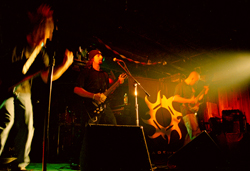
In the following band meeting, I explained my misgivings about the lack of quality I expected to encounter. That said, the band also knows my priority when working in a non-optimal setting: vocals will always be heard, I’m a kick drum “Nazi,” and guitars/bass will then be added as allowed.
We roll up to the club, “meet and greet” goes just fine, and then I quickly head upstairs for my initial first-hand look at the room and tools that will serve us over the next few hours. Yep, a long room with parallel walls, along with unfinished ceiling – actually, a bare tin roof.
The house guy is extremely accommodating, the systems are arranged as we requested, and he lets us have a two-hour house and monitor system tweak-fest.
Right away, I high-pass the entire system at 45 Hz to “save rail” on the subwoofer amps.
The subs, housed in monstrous boxes that look like modified Altec “Voice of the Theatre” systems, are loaded with new, and rugged 15-inch cones.
Dual 12’s carry out the order for mids, and a raw, gigantic JBL compression drivers sit behind two-foot horns on top of each left and right speaker pile.
Mike, our monitor engineer, suggests we aim the two guitarists’ (four by 12-inch loaded) cabinets at the rear corners of the stage to help control stage volume. Good idea, and I readily agree with the approach.
We gave the house wedges and side fills a real workout. I checked the lines up front, and Mike called back the monitor cuts. Side fills carry guitars, kick, and high notes of the bass. The center wedge handles lead vocal and more guitar.
The bass was put on a custom DI that I had modified with silver wire, silver solder, and a transformer surrounded by ferrite. Still, the “slap and ping” of the bass had to be fine-tuned, along with beater click of the kick drum between 4.5 kHz and 6 kHz.
The house AKG D112 large-diaphragm microphone was applied to kick drum, while the Shure SM57 mics on guitars were tailored to sacrifice frequencies from 1 kHz to 4 kHz, helping with vocal clarity up front.
HOT METAL IN COLD IOWA
While the house guy fought feedback while mixing the warm-up bands on the bill, we had a smooth show. The mains sounded much better than anticipated, and surprisingly, my mix was much easier to pull together than previously assumed.
Our bass and kick drum relationship melted together nicely, helped by a parametric EQ slaughter of everything between 200 Hz and 600 Hz. The only thing I have to compromise for the entire mix is pulling some top end out of the snare drum because vocals are (as always) the high priority of the night.
The locals, owner and bartenders noted they hadn’t heard the system or room sound quite as good before. And in fact, it’s wasn’t hi-fi, but it was clean, loud and feedback free, definitely not among the worst gigs I’ve had to work.
It was a cold night in Iowa, but the system was as dialed-in as we could get it, the crowd got rowdy and the metal music was hot and flying. It sure did make for a better, but still cramped, ride home… I’m wondering,, where’s our next gig? I wonder what the system’s going to be like? Can we do any better than tonight? All I can think is you’ve got to try.
Nathan Short is a working mixer in the Chicago area.
